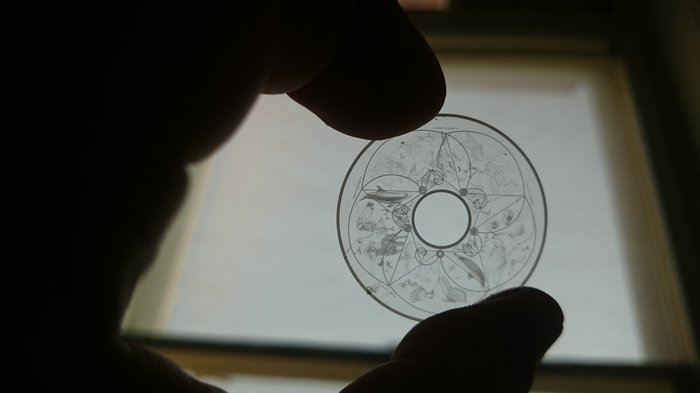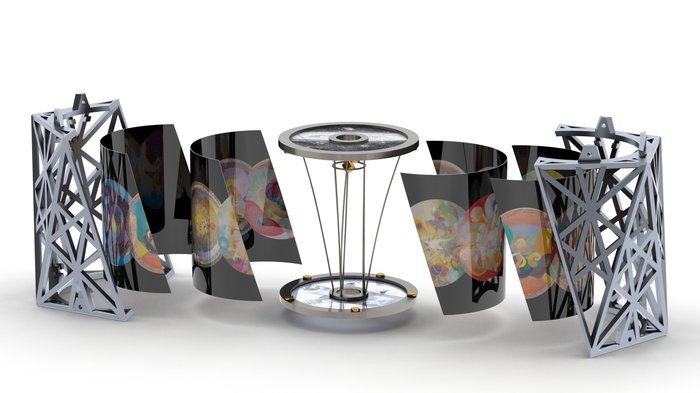.

This platinum-engraved sapphire disk, part of a set illustrating Earth's biodiversity, will be housed in the Earth Chamber of the MoonArk. It's designed by Mark Baskinger with Matt Zywica, Maggie Banks, Christie Chong, Bettina Chou, Adella Guo, Natalie Harmon, Deborah Lee, Deniz Sokullu and Carolyn Zhou.
-
Courtesy of The Moon Arts Project
DNA from a genetically modified goat, a spritz of perfume, sculptures so small you need a microscope to see them.
They're all headed for the moon.
The MoonArk is a sort of eight-inch-tall portrait of humanity, with more than 200 artists and designers contributing to it. There's space reserved for it on one of the privately-funded Moon missions competing for the Google Lunar Xprize.
Lowry Burgess, a professor at Carnegie Mellon University and the MoonArk project lead, holds up one of his contributions, a vial full of red liquid. A drop will go in the Ark.
It's human blood — "all artists' blood," Burgess says.
.

The MoonArk features four chambers — Earth, Metasphere, Moon and Ether — surrounded by an aluminum exoskeleton. Here, a 3-D rendering shows the Metasphere Chamber.
Courtesy of The Moon Arts Project
-
You may have realized that this is conceptual art, where the idea is more important than any traditional aesthetic.
Or you can think of it is as a time capsule, with its contents open to interpretation.
Burgess sees it as a cultural outpost in space waiting to be discovered.
"We're desperately hoping that whoever opens it is perhaps a little more evolved than we are," he says.
Unlike some earlier space art, like the Golden Records on the Voyager craft floating beyond the solar system, the Ark will stay in one place.
But Mark Baskinger, one of the artists on the project, says the point is not to conquer.
"We think it should be different than sticking a flag in the soil and claiming territory ... maybe we're leaving breadcrumbs for someone else to find their way back here," he says. "It's an attempt to communicate forward in time — it's an attempt to communicate outward."
Other artists are just interested in the collaboration — some don't even really care about space or who finds it.
And while some of the artists are prone to intellectualizing, others will let themselves get a little emotional.
Dylan Vitone's contribution includes ordinary text messages between him and his wife.
.

One of the murals in the Metasphere Chamber, "Texts to Elaine," features personal photographs Dylan Vitone sent to his wife over a five-year period.
Courtesy of the Moon Arts Project
-
"Cynical me is critiquing the way we broadcast our life. The sentimental me is kind of celebrating this thing that's really important for me and trying to give it more meaning than it actually has," he says.
A copy of the Ark will stay here on Earth to be exhibited.
But in space, weight is money, so the team has had to be innovative with materials. The Ark's four chambers will weigh less than six ounces.
I pick up one of the aluminum outer shells. It's so light it almost feels flimsy, but it's designed to last hundreds of years.
"It's funny — you touch this and your fingerprints are on it," Vitone says. "Your fingerprints are going to the moon."
Suddenly, the moon is personal.
My fingerprints are just a simpler form of self-expression than the other items on the MoonArk.
Quelle: npr
4334 Views
